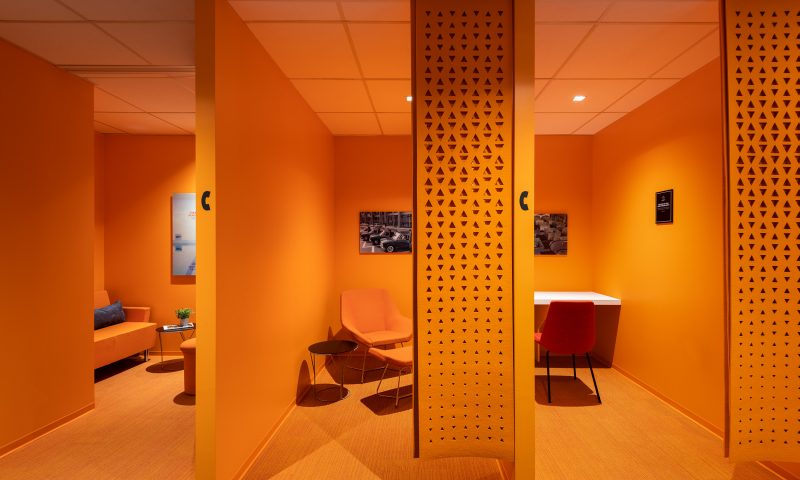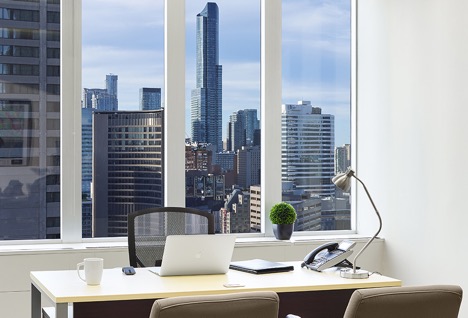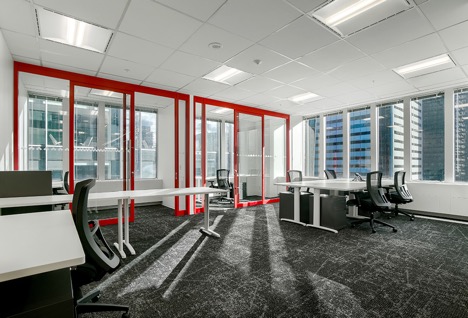How to Navigate Returning to the Office

When COVID-19 first hit and cities issued stay-at-home orders, everyone’s major concern was whether or not they could adjust to a life of isolation. “It will be over soon, right?” was the universal phrase being uttered worldwide across virtual meetings and calls, over the course of March and April.
Now however, months into this new normal, we have all adapted (to varying degrees) to a world in which the pandemic is not yet over, but in which we are all learning to exist alongside it. As we enter Fall, cities have been lifting restrictions, businesses are being allowed to reopen, and companies are looking to call their employees back to the office. Many individuals and entrepreneurs are also looking into finding designated workspaces again.
Though we cannot predict the future, it is likely that cities will remain open to a certain extent despite the pandemic and with these changes in the air and the number of cases fluctuating, many have renewed concerns about what returning to work and the public world is going to look like. It is a stress called “re-entry anxiety” – a combination of fear of exposure to the outside world and health-related anxiety about COVID-19.
For many, this fear arises in the context of having to return to the office. There is so much more uncertainty that exists in our new world and people are going to have to learn how to navigate it, especially as the working world begins to open its doors again. Managing public transport, using public facilities, and how to share space with colleagues again can be nerve wracking to say the least.
Many companies are looking to call their employees back to the office, even within the uncertainty of the pandemic, and it’s understandable why. For those who work in creative industries, it has become much harder to create space for collaboration and unplanned brainstorming when all of your meetings are virtual. We are all waiting for lulls, muting and unmuting our microphones to speak only when the opportunity presents itself – much like our younger selves raising hands in class. Due to these limitations, certain fields of work need a communal space to come together to produce their best work.
Another reason is that companies are going to face larger organizational commitments with prolonged remote work. Now that we are months on from the start of this whole endeavor, companies will have to start looking into restructuring their performance and accountability indicators if remote work goes on for much longer.
Having an entirely remote team calls for different arrangements and this feat may not be possible for some organizations. We have seen multiple accounts of cybersecurity threats in the virtual work world and the financial cost of tech support, cybersecurity software, and hardware for a distributed team can be too much for some businesses.
Company culture is also a common loss that is being talked about during the pandemic – many employees have lost their sense of their work culture and sense of belonging. They are not getting the small interactions and happy exchanges with their colleagues that help them feel like they are a part of a collective. With this new sense of isolation added to the physical separation, companies are looking to help their employees come together again.
However, returning to the office is not just a company-level desire. If you are not one of the people who are being asked to return to the office, you may still be interested in returning to a workplace again. We know that many people are struggling with remote work, especially when it does not have an end in sight for some. With crowded home spaces, childcare obligations, and small apartments, a lot of people are finding it harder to work from home every day.
Mental health is a universal worry and many are finding that their productivity and morale are continuing to decline with remote work. Whether you are being asked to return to the office or you are looking into finding a workspace outside of your home, re-entry anxiety is a normal feeling in 2020. That said, there is a lot you can do to help yourself transition back into the workplace.
What to do?
Know What Is Safe:
Follow the guidelines put in place by your respective government. Take note of how many people can be in one space at a time and remember to wear a mask when you are indoors or when you cannot physically distance from others. Try your best not to touch your face and mask, while also cleaning your hands frequently with hand sanitizer or soap. Try to stay 6 ft away from others when possible and make sure the people around you are also abiding by the guidelines.
Know Your Boundaries:
If you are worried about branching out of your routine, it is important to figure out what your boundaries are prior to making changes. What would it look like for you to go somewhere? What are your limits? If you go somewhere and there are too many people not abiding by the guidelines, will you leave? If someone sits next to you on public transit, will you move? Being sure of your boundaries prior to trying to make changes will help ease some of the uncertainty. Knowing what to do if you are uncomfortable gives you an instant plan of action.
Understand the Difference; Deliberate Risk vs. Uncontrollable Risk:
Going to work is a necessity, either because your employer is asking for it or for your own productivity and wellbeing. This is uncontrollable risk and it is accepted because essentially everyone is potentially exposed to COVID-19 at some point in their daily life. Whether that be from going to the grocery store or going to work, it is okay to explore the realm of uncontrollable risk as this is learning to live in our new normal.
Deliberate risk is different and can be exemplified by not wearing a mask when expected to or going to large gatherings with numbers higher than the allowed limit. Differentiating between the two can help you come to terms with branching out of your comfort zone and trying new things. As long as you are being safe and following the guidelines set by your government, it is okay to increase what you are exposed to.
Check in with your Employer/Workspace:
If you are being asked to come into the office, make sure you know what the new protection protocols are. What is your employer or office provider doing to keep you safe? What is the protocol when someone is feeling ill? Know what safety measures are in place and what the rules are being implemented. This will keep you as safe as possible and also help in regulating everyone else’s behaviour.
Flexible workspaces, such as The Professional Centre, have implemented new safety measures for both individual entrepreneurs and company offices to ensure their space is as safe to use as possible.
If you are an individual who is looking for a designated workspace away from home, sitting in a café right now may not be an option. You cannot control the actions of every person who walks in off the street and with physical distancing measures in place, you cannot guarantee you will always find a spot. One option is to look into renting a desk at a flexible workspace provider. Flexible workspaces are safe and controlled workspaces with rules and procedures that will help you adjust and give you a secure space to work in.
Small Steps:
We are definitely not suggesting that on your first try you get on the subway, go to the office, take a cab, go shopping, and have dinner at a restaurant. That would make anyone feel overloaded! It is important to break up your tasks and set small goals. If going back to the office is a priority, start with going in a few times a week. Test your limits and see what you can manage.
The first few tries may be difficult and you may experience moments in which you feel unsafe, but it will eventually become easier. You will get more comfortable with each day you try, and the more you get used to, the more you will be able to do (all while being as safe as possible). Remember that it is not all or nothing – this is the long haul.
Start Sooner Rather Than Later:
The longer you put it off, the larger the anxiety and fears will become. We all have to adapt to this new normal and everyone is going at their own pace, so try to implement new small experiences every few days. This will build up your emotional tolerance to new experiences.
Do Not Rely on Crutches:
Do not start substituting your anxiety for a crutch. This means staying away from substances like alcohol, nicotine, and drugs. These can lead to prolonged mood imbalances and can contribute to actually feeling more anxiety in the long term.
Finally, remember that you will make it through this. Humans are incredibly resilient and adaptable and that includes yourself. Remember when you thought prolonged quarantine was unheard of? You did it and you will find that it is the same with returning to the office. Every day, the fear and anxiety will lessen, and you will start to adapt to our new normal. Everyone is in this together and we will all find new ways to exist and evolve while the pandemic continues.
Rethinking your organization’s workspace? Discover our flexibly designed and fully managed enterprise office solutions.
How To Maximize Privacy In A Coworking Space

Coworking has taken the business world by storm. It’s effective, it’s trendy, and it takes all the best aspects of the new sharing culture. For some, however, all that sharing is a cause for concern.
To address those concerns, we’re providing a few easy tips for maximizing your privacy while working in a coworking space.
Digital Security
Estimates believe that by 2021, cybersecurity will cost business $6 trillion per year in aggregate. And half of all cyber-attacks are against SMBs. For all businesses, whether in a traditional or coworking office, digital security matters.
Password Managers
Companies in coworking spaces are notorious for being at the forefront of industry trends. In theory, this should help keep them abreast of security risks, but it can come with some drawbacks. For one, they tend to sign up for a lot of tools, services, and demos.
Keeping track of all those different passwords and usernames is a lot to keep in your head. So, too often we revert to just using the same combinations over and over. This puts your digital security at risk. If someone figures out the password once, they can access all your software.
A good solution is to use a password manager. This gives you an easy solution to store your passwords in one secure location. So you can vary up your passwords without fear of forgetting them, or of getting hacked.
Cloud Tools
Cloud software also helps protect your vital information, without compromising efficiency. It gives you a secure platform to store important documents and files that you can access anywhere, on any device.
As well, in the true coworking spirit, the cloud makes it easy to collaborate with your team. It allows you to share access with specific people, allowing them to review, access, or edit files. It’s not only great for coworking privacy, it’s also ideal for productivity.
Privacy At The Desk
Of course, not all privacy concerns live online. Nor are they all security-related. Sometimes, you just want your space to feel a little more like your own.
Privacy Screens
If you have a nosey desk neighbour or simply want to have your space a little more defined, a privacy screen may be your best bet. These screens come in all sorts of shapes, sizes, and types. From full cubicle style screens to ones that sit on your desk, just high enough to block your monitor.
There are also less, formal screens you can use. For example, a desk plant can increase your coworking privacy without making it look like you’re trying to keep others out. As well, they add other benefits like filtering air, emitting pleasant aromas, and inducing calmness.
Filing Cabinets
Filing cabinets are another good idea for your personal privacy in a coworking space. Getting one with a lock not only helps you organize your files, but allows you to feel secure when leaving equipment in the office overnight.
Technology
Privacy tech doesn’t just protect you online. Many shared office spaces also leverage physical technology for better privacy.
For instance, cloaking technology is becoming increasingly popular for meeting rooms. They place a strip on the glass that prevents outside viewers from reading the screen during presentations.
This lets your meeting space have big windows, for a more open feel, without sacrificing privacy. As well, it can make any clients or investors you meet with feel more secure.
Private Office Space
You can also rent private office instead of open space in coworking offices. These offices are available for teams or for individuals. They let you enjoy the best of both worlds. You have access to all the amenities and collaboration of an open office, with the privacy of your own space.
This is especially useful for teams that make a lot of phone calls or deal with private or secure information.
Book A Tour In A Downtown Toronto Coworking Office
At the Toronto Professional Centre, we understand that coworking privacy is a major concern. We take great care to create spaces that are functional, secure, and comfortable.
Our diverse range of open and private office space can fit the needs of any size or type of business.
Book a tour today and discover the benefits of coworking with TPC.
Open vs Private Office Space: Which is Best for My Business?

The last decade has given rise to the Googleization of offices. A focus on collaboration and freeform thought has lead to companies shifting to the open office format. But are open offices better than private? It depends on your business & needs.
In this article, we weigh the pros and cons of each.
Open Office Space
The coworking explosion saw a dramatic shift towards open office spaces in all sorts of businesses. Cubicle walls melted away, opening up to create collaborative workspaces.
It’s a phenomenon that gained popularity at new age giants like Google and Facebook. Companies were quick to adopt, in hopes of capturing some of the same success.
Now we’re a few years into mainstream open office spaces and we’re taking an objective look at their pros and cons:
Open Office Pros
Collaboration
Collaboration is the most touted benefit of the open office. Putting people of different levels and functions into one space opens up the dialogue and offers more perspectives. The result is more harmonious, agile thoughts and ideas. As well, it reduces miscommunication and streamlines ideation.
The immediacy and accessibility that an office space provides to team members make it ideal for collaboration.
Growth
For companies in a state of anticipated or unsure growth, open office space rentals are ideal. These spaces are dynamic and adaptable. It’s easy to rearrange space and/or add desks. This allows for rapid growth if you need to scale up the workforce quickly.
Growing businesses save time and money on having to look for new offices.
Costs
Open offices are the most economical way to set up your office. It’s what has made them a staple of the Toronto coworking landscape. Cubicles, private, and individual offices take up more space and cost more to set up. On average, an open office space takes up less than 1/3rd of the space of a traditional office.
Businesses of all sizes are focusing on becoming leaner and more productive. An open office provides the perfect balance between quality and price point that fits many modern companies.
Open Office Cons
Interruptions & Distractions
The ease of collaboration can cut both ways. While it’s easy for people to communicate and discuss ideas, it’s just as easy to distract each other. According to studies by the University of California, Irvine, distractions happen 29% more often in open offices.
Approaches can be taken to mitigate distractions. Setting time for socialization can help reduce distractions throughout the day. Allowing for flex work, so employees can work from home when they need distraction-free work days, can help. As well, wearing headphones can help keep employees plugged into their own work, so they are interrupted less often while still being readily available.
Lack of Privacy
Constant collaboration isn’t for everyone. Some people, especially those from a more old school background or mentality, prefer private office space. For them, the four walls of an office aren’t restrictive, they’re a comfort. Privacy can offer freedom from distraction and makes your workspace feel like your own.
Lack of Permanency
While the agility of renting open office space is generally a benefit, there is a flipside. The whole, “move fast and break things,” mentality comes with a lack of permanency. While it’s proven to be a formula for success and rapid growth for many businesses, it’s not for everyone.
Agility allows you to push boundaries and scale fast, but more permanent workspace can provide a sense of comfort. It’s important to find the balance that meets your company’s needs and culture.
Allowing workers to personalize their desk space with plants, photos, and knickknacks can help them feel like their space is their own. As well, minimize unnecessary shuffling around of space.
Private Office Space
Private offices are the more traditional approach. Employees show up in their private offices and it’s their home for the day. The four walls of their cubicle or office are familiar and comfortable. In the wake of the open office boom, many companies are partially shifting back to private offices. They’re often used now for management roles or specialized jobs.
Private Office Pros
Privacy
One of the most obvious benefits of a private office is privacy. Workers can complete professional or personal matters in their own space. It also makes it easier to deal with sensitive matters such as legal, HR, or financials without alerting or involving the whole team.
Often, salespeople who are on frequent calls will prefer a private office. The calls are less of a distraction to those around them, and they can have the comfort of a private call.
Interruptions
Another benefit of a private office is the lack of interruptions. People are less likely to disrupt or interrupt you while in a private space. This makes it easier to focus on your own work and reduces distractions.
In addition to interruptions, the noise of an open office can be disrupting. 58% of high-performance employees desire a quieter workspace. A private office offers more control over sound.
Individual Productivity
The lack of interruptions helps individuals to be more productive throughout their day. Employees can accomplish their individual tasks faster and with high-quality. Their interactions are more streamlined, usually occurring on their own terms.
Private Office Cons
Reduced Collaboration
Although a private office improves individual productivity, it can reduce team productivity. Where there are fewer interruptions, there are also fewer opportunities for communication and collaboration.
The result is less innovation at the expense of individual productivity. Companies need to decide which is more important to them in deciding between open and private offices.
Isolation
Having the privacy of your own office can be nice and comfortable. But it’s also isolating. Spending days locked away alone in your own office can take a personal toll. It reduces your participation in company culture and can take away from workplace wellness and job satisfaction.
If working with private offices, be sure to schedule social time and try to pair break times with other employees. Solutions like Steve Jobs’ walking meetings can help to engage coworkers and break up the mundanity of spending all day cooped up in an office.
Costs
For all the comforts that come along with a private office, there is a definite cost. They take up more space, they cost more to put together, and moving in and out of spaces is more time-consuming and expensive than an open office.
They can have other cost benefits, however. For example, employers can use a private office as an incentive during promotions rather than just giving raises.

Private Office in a Coworking Space
A private office in a coworking space is another option that provides a healthy balance between the pros and cons of open and private offices. These are available for individual offices or team offices. They offer the best of both worlds, combining the privacy of your own office with the collaboration of an open office.
These offer the best value for individuals or small teams who are looking to rent private offices. They come at a lower cost than renting traditional business space while having all the amenities of a large company.
Private Office & Open Office Office Space for Rent in Toronto
Whether your company’s needs are best met by renting private or open office space, quality matters. Our Toronto coworking spaces are top quality. We have prime Financial District real estate, professional design, and all the technology and amenities a modern office needs.
Our diverse range of open and private office space can fit the needs of any size or type of business.
Book a tour today and discover the benefits of coworking space.








